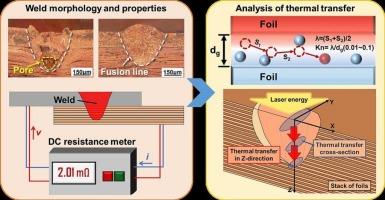预载调制对多层铜微箔和阳极盘激光焊接质量的影响
IF 5
2区 物理与天体物理
Q1 OPTICS
引用次数: 0
摘要
在圆柱形锂离子电池中,叠铜箔(全片结构)和阳极盘的高质量焊接至关重要。焊接不良会导致气孔和不均匀的形成,这可能会损害电流能力或造成过热的风险。激光焊接是首选,因为其最小的热量输入和高速的能力。然而,叠层铜箔与阳极盘之间的超薄层间隙对焊接过程中的热传导有显著影响,但目前对其的研究较少。在本研究中,研究了精确调节预紧力对多层铜箔堆和阳极盘激光焊接质量的影响以及微间隙中潜在的热传递。通过检测焊缝表面形貌和断面形貌,对焊缝质量进行了综合评价。结果表明:在预紧力为20 ~ 60 N的范围内,随着预紧力的增大,焊缝表面缺陷增多,预紧力过小导致焊透不完全。随着预紧力的增加,焊缝深度和宽度有所增加,但在预紧力约为40 N时,焊缝截面波动率降低至34.3%,气孔和孔洞缺陷减少。焊缝的电阻值较低(2.05 mΩ),抗拉强度较高(59.9 N)。理论分析表明,超薄箔间气隙以滑移流动形式存在较大的热阻。预载荷的大小决定了缝隙的热阻,从而直接影响了激光焊接的传热效率。最佳预紧力约为40 N时,可获得深度大、缺陷少的高质量焊缝,而过小的预紧力会导致深度不全,过大的预紧力会导致焊接过程不稳定。本研究确立了预载优化是提高多层铜箔焊接可靠性的有效策略,为优化电池制造过程中的夹具条件提供了新的见解。本文章由计算机程序翻译,如有差异,请以英文原文为准。

The effect of preload modulation on laser weld quality of multilayer copper micro-foils and anode disk
In cylindrical lithium-ion batteries, high-quality welding of the stacked copper foil (full-tab structure) and the anode disc is critical. Poor welding can induce porosity and non-uniform formation, which may impair current capability or pose risks of overheating. Laser welding is the preferred choice, owing to its minimal heat input and high-speed capabilities. However, ultrathin interlayer gaps between stacked copper foils and anode disks significantly affect heat conduction during welding, yet it has received limited attention. In this study, the effect of precisely modulating the preload on the laser weld quality of multilayer copper foil stacks and anode disks and the underlying thermal transfer in the micro-gap was investigated. The weld quality was comprehensively evaluated by examining surface and cross-sectional morphology. It was found that within the preload range of 20 N to 60 N, the weld surface defects increased with higher preload, while too little preload led to incomplete penetration. Although the weld depth and width are enhanced with increasing preload, the weld cross-section exhibits lower volatility and fewer porosities at a preload of approximately 40 N. The cross-section fluctuation of the weld was reduced to 34.3 % at 40 N preload, with fewer defects of voids and pores. The weld had a lower resistance value (2.05 mΩ) and higher tensile strength (59.9 N). Theoretical analysis indicates that the ultrathin inter-foil gas gap operates in a slip-flow regime with substantial thermal resistance. The preload governed the thermal resistance of gaps, thereby directly altering thermal transfer efficiency during laser welding. Higher quality welds with greater depth and fewer defects were obtained with an optimum preload of about 40 N, whereas too small preload induced incomplete depth and excessive preloads destabilized the welding process. This research established preload optimization as an effective strategy for enhancing multi-layer copper foil welding reliability, providing novel insights for optimizing fixturing conditions in battery manufacturing processes.
求助全文
通过发布文献求助,成功后即可免费获取论文全文。
去求助
来源期刊
CiteScore
8.50
自引率
10.00%
发文量
1060
审稿时长
3.4 months
期刊介绍:
Optics & Laser Technology aims to provide a vehicle for the publication of a broad range of high quality research and review papers in those fields of scientific and engineering research appertaining to the development and application of the technology of optics and lasers. Papers describing original work in these areas are submitted to rigorous refereeing prior to acceptance for publication.
The scope of Optics & Laser Technology encompasses, but is not restricted to, the following areas:
•development in all types of lasers
•developments in optoelectronic devices and photonics
•developments in new photonics and optical concepts
•developments in conventional optics, optical instruments and components
•techniques of optical metrology, including interferometry and optical fibre sensors
•LIDAR and other non-contact optical measurement techniques, including optical methods in heat and fluid flow
•applications of lasers to materials processing, optical NDT display (including holography) and optical communication
•research and development in the field of laser safety including studies of hazards resulting from the applications of lasers (laser safety, hazards of laser fume)
•developments in optical computing and optical information processing
•developments in new optical materials
•developments in new optical characterization methods and techniques
•developments in quantum optics
•developments in light assisted micro and nanofabrication methods and techniques
•developments in nanophotonics and biophotonics
•developments in imaging processing and systems

 求助内容:
求助内容: 应助结果提醒方式:
应助结果提醒方式:


